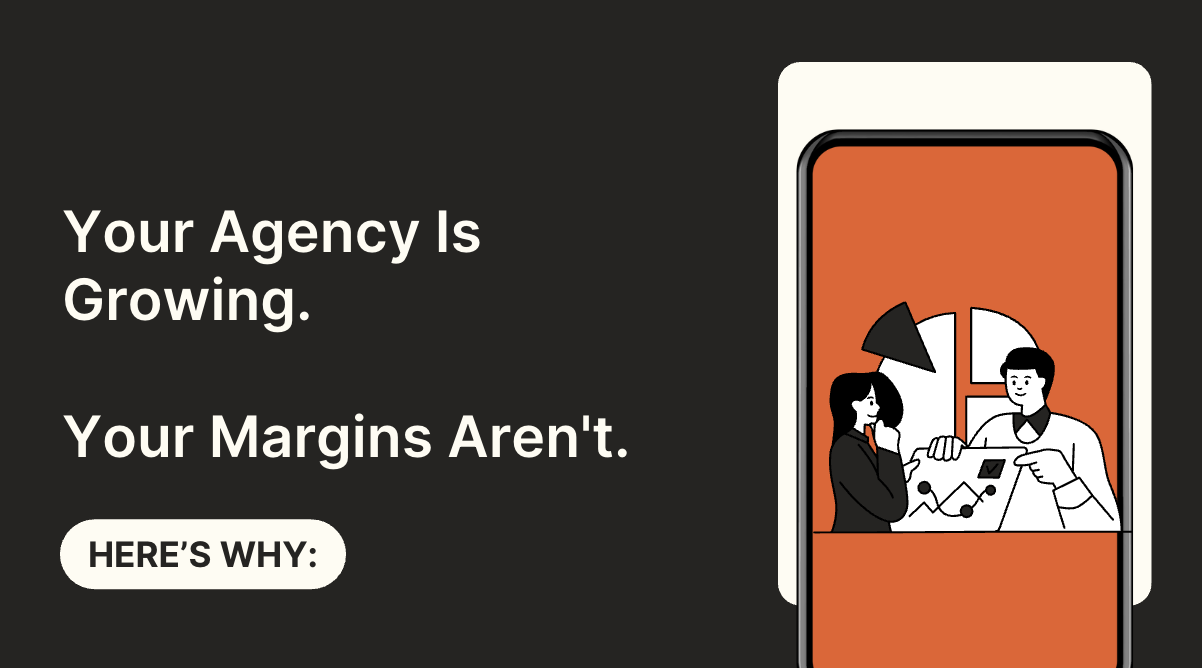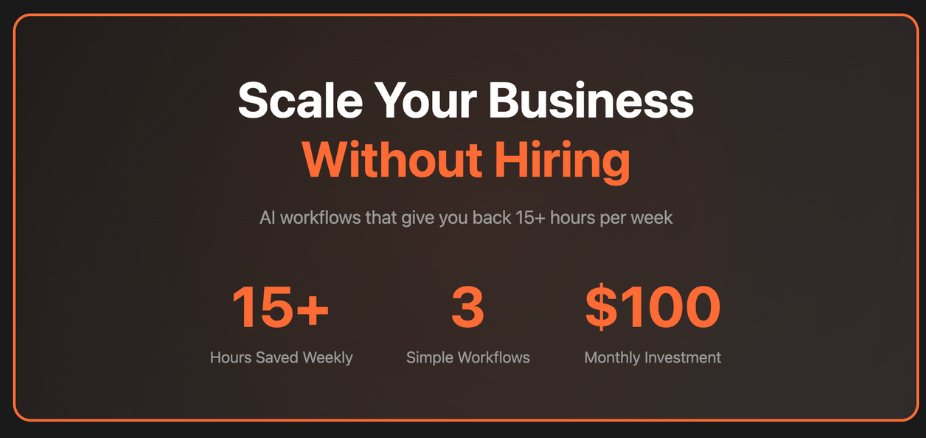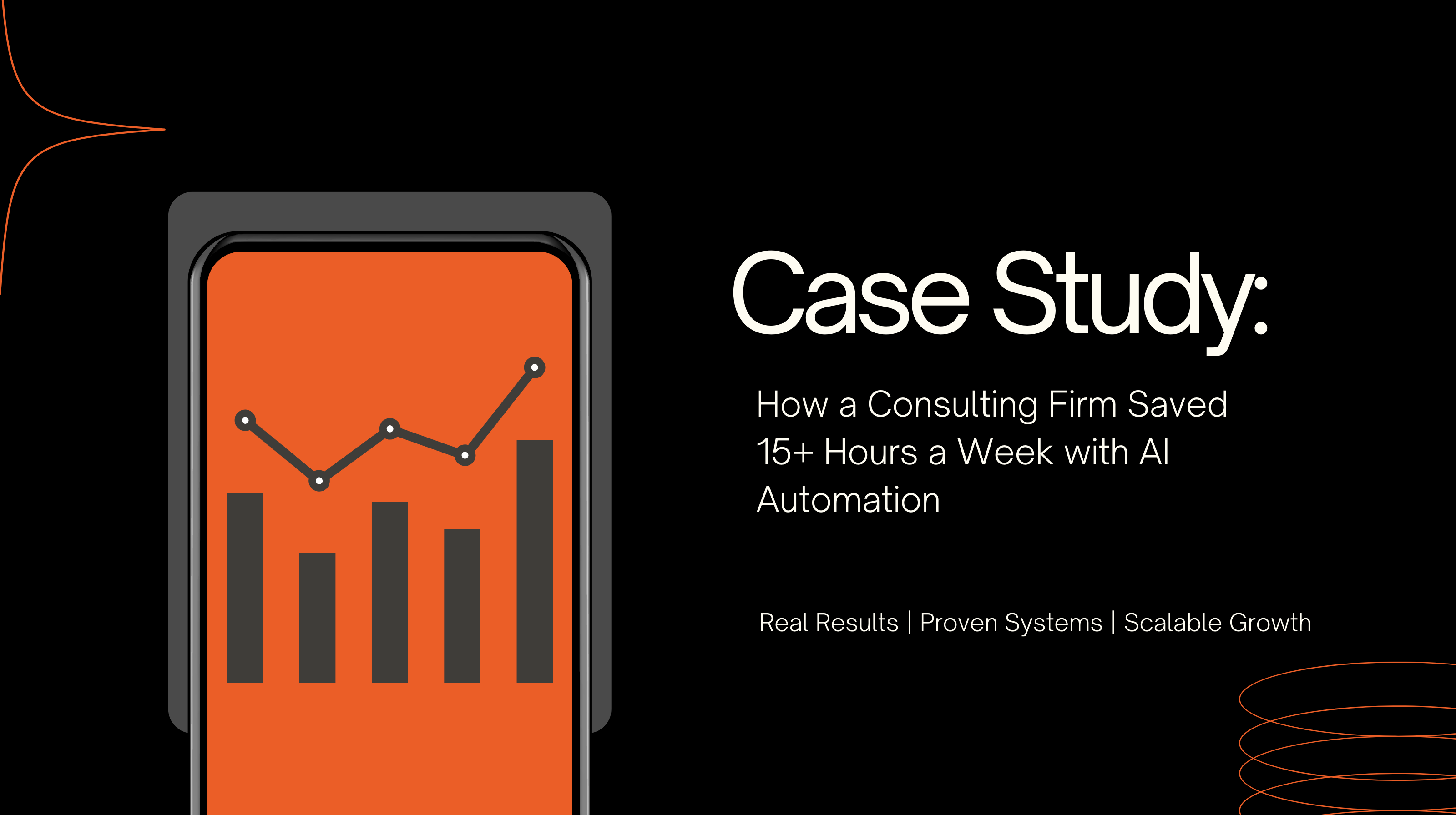Your Agency Is Running on Borrowed Time. Here's Why.
Your agency has achieved something remarkable: steady revenue, a growing team, and clients who trust your expertise. You should be celebrating. Instead, you're drowning in operational chaos, watching talented team members burn out, and losing clients you fought hard to win.
Here's the uncomfortable truth: while you're celebrating linear growth, AI-powered competitors are achieving exponential leverage.
The numbers tell a sobering story. By the end of 2025, approximately 85% of enterprises are expected to implement AI agents, and businesses using AI agents report 55% higher operational efficiency and 35% cost reductions. The gap isn't just widening, it's becoming a canyon that traditional agencies can't cross.
Every manual process in your agency, from wrestling with complex API integrations to optimizing ads based on increasingly unreliable data, is a human bottleneck that caps your growth potential and bleeds margin. The enterprises that survive the next decade won't be those with the most capital or the largest teams. They'll be those with the most sophisticated AI infrastructure.
The Real Enemy: The Complexity Trap That's Killing Your Agency
Most agency owners respond to growing pains the same way: add more tools, hire more people, implement more processes. These band-aid solutions don't address the root cause—the lack of a unified, scalable system—and only compound the problem.
The progression is predictable and painful:
Stage 1: The Hustle Phase (0-10 Clients)
Everything feels manageable. Systems are "whatever works." You're scrappy, responsive, and clients love your personal touch. This stage feels sustainable, but it's not.
Stage 2: The Complexity Trap (10-25 Clients)
Information gets lost between platforms. Team members step on each other's toes. You're constantly putting out fires instead of building campaigns. According to industry data, agencies gained an average of 6 to 9 new clients in 2022 but managed to retain only about 44% of them, resulting in churn rates that sometimes exceed 60%. Client satisfaction starts slipping, and you can feel it.
Stage 3: The Breaking Point (25+ Clients)
Systems collapse under their own weight. At retainer-oriented agencies, client turnover rates higher than 20% signal that another 20-30% of clients are currently at risk. Your best people quit, drowning in repetitive work that machines should handle. Growth stalls. Revenue plateaus.
The fundamental problem isn't growth itself—it's trying to build a skyscraper on a foundation of duct tape and prayer. And here's what makes it worse: the data you're relying on to make decisions is fundamentally broken.
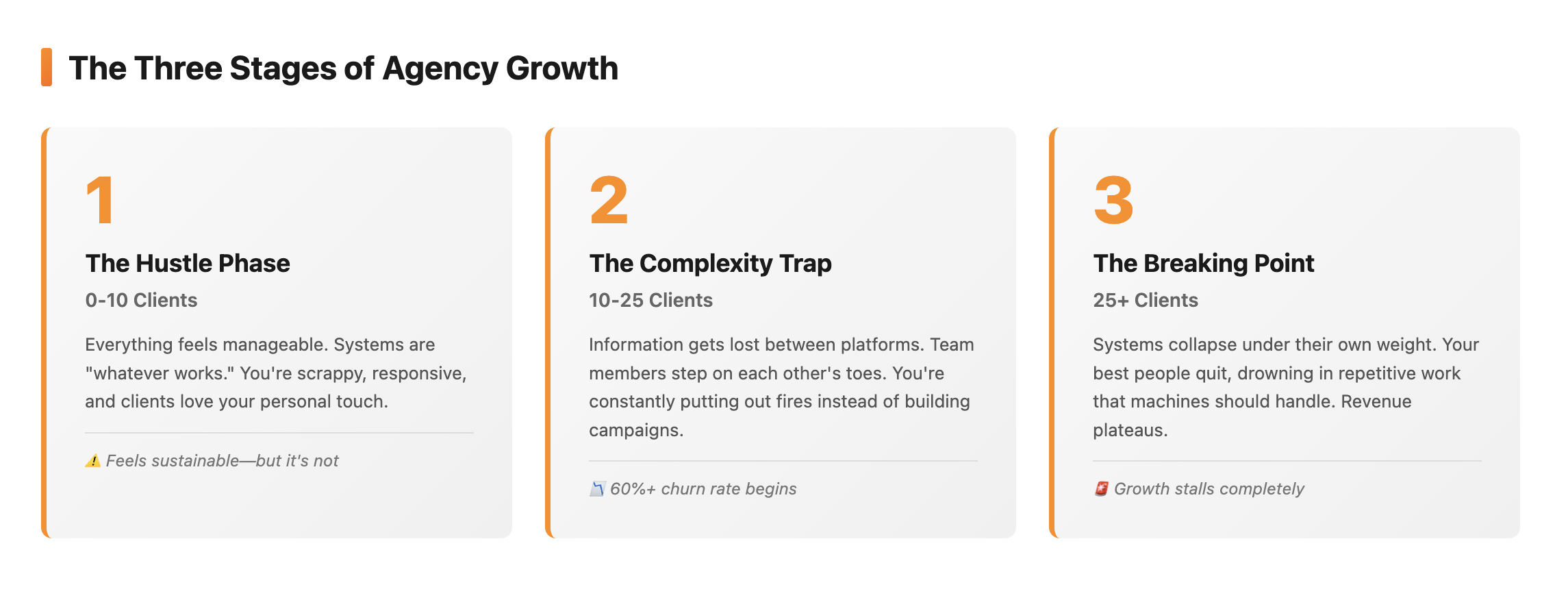
The Three Pillars of Unstoppable Agency Growth
The agencies winning in 2025 aren't the ones with the biggest teams or the most clients. They're the ones that have architected their businesses on three non-negotiable pillars, transforming human-constrained operations into self-optimizing profit engines.
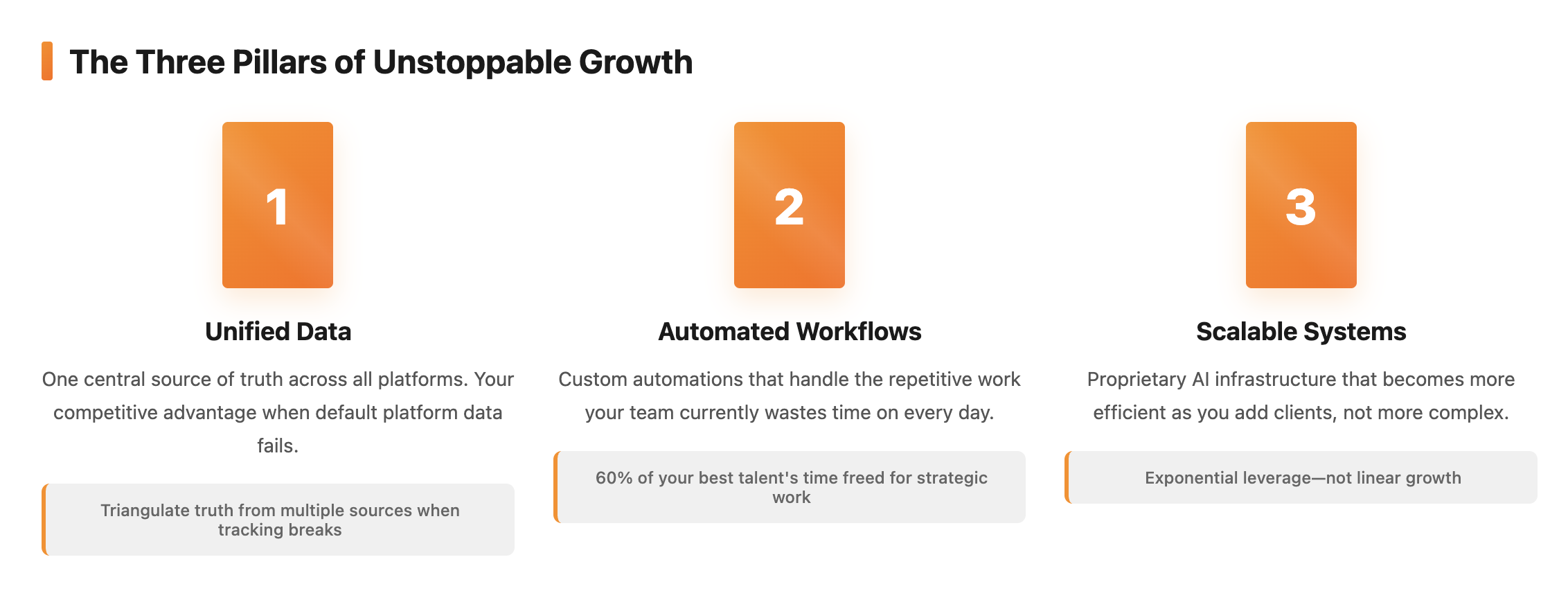
Pillar 1: The Single Source of Truth
Every piece of critical information must live in one central, accessible location. This isn't just about organization—it's about survival.
Your robust data foundation becomes your competitive advantage when default platform data fails. When Facebook can't track accurately, agencies with unified data systems can triangulate truth from multiple sources: CRM data, server-side tracking, first-party data platforms, and advanced analytics tools.
This pillar prevents catastrophic missteps like:
- Ignoring critical audience insights (demographics, behaviors, preferences) because they're scattered across six different platforms
- Failing to adjust campaigns based on actual conversion data versus Facebook's incomplete picture
- Making strategic decisions based on surface-level metrics that don't tell the whole story
While 77.4% of organizations are experimenting or in production with AI, 77% rated their organizational data as either average, poor, or very poor in terms of quality and readiness. Your data infrastructure determines whether AI becomes your competitive advantage or just another expensive disappointment.
Pillar 2: The Action-Oriented Workflow
Here's a stat that should terrify you: up to 60% of your best talent's time is wasted on repetitive work that machines should handle.

Businesses using marketing automation see an average $5.44 return for every $1 spent, translating to a 544% ROI over three years. Yet most agencies are still using manual processes for tasks that should be automated.
Your team should spend 90% of their time on high-value work—the strategic thinking, creative development, and client relationship building that actually generates revenue—not managing tools, clicking buttons, and chasing status updates.
This requires deploying custom automations for:
- CRM updates and data synchronization
- Lead research and qualification
- Campaign reporting and analysis
- Client communication workflows
- Performance monitoring and alerts
Technical flexibility is critical here. 77% of marketers use AI-powered marketing automation to create personalized content in 2025, but not all platforms are created equal. Platforms with full JavaScript/Python support allow developers to quickly build complex workflows that basic tools can't handle. The difference between three days of coding work and two hours isn't just about efficiency—it's about what becomes possible.
Pillar 3: The Scalable System
Generic automation tools are designed for simplicity, not scale. They work brilliantly when you have five clients and basic needs. They become expensive limitations when you're managing complex, multi-channel campaigns for dozens of clients.
Your operations must be designed to become more efficient as you add clients, not more complex. This requires moving past simple automations (like basic Zapier connections) that you'll outgrow in weeks.
The scalable system relies on proprietary AI and automation infrastructure that creates exponential leverage. 90% of businesses report better workflow with generative AI agents, while 79% of employees say AI has enhanced overall business performance. This infrastructure supports critical strategies like:
- Sophisticated A/B testing: Running comparative analysis across ad elements at scale, something impossible to manage manually
- Full-funnel optimization: Moving beyond conversion-focused campaigns to orchestrate entire customer journeys
- Dynamic budget allocation: Automatically shifting spend based on real-time performance across accounts
80% of organizations will adopt intelligent automation by 2025, and the economic advantages are clear. Advanced platforms charge per complete workflow execution regardless of complexity, providing major advantages for high-volume data processing compared to platforms that bill per operation.
The Economic Reality: Automation Isn't Optional Anymore
Let's talk about what inaction costs.
High churn rates impact agency health directly—if you're losing clients as fast as or faster than you're gaining them, your revenue takes a hit because winning new clients costs more than keeping the ones you have. In fact, it costs 5 to 25 times more to acquire a new client than to retain an existing one.
When your team spends 60% of their time on repetitive tasks, you're not just wasting salary dollars—you're missing opportunities. Every hour spent manually updating CRMs or copying data between systems is an hour not spent on strategic work that drives growth.
Meanwhile, the global agentic AI market is projected to grow from $5.25 billion in 2024 to $199.05 billion by 2034, expanding at a CAGR of 43.84%. This isn't future speculation—it's happening now. 70% of marketing leaders plan to increase investment in automation in 2025.
The question isn't whether to build AI infrastructure. It's whether you'll build it before your competitors make your agency obsolete.
Stop Trading Hours for Dollars: Your Next Move
You don't need another project management tool or another software subscription. You need a fundamental reimagining of how your agency operates.
Companies using marketing automation see a 10%+ boost in revenue within 6-9 months due to improved lead management. But the real transformation goes deeper. When you architect your agency on the three pillars—unified data, automated workflows, and scalable systems—you unlock:
- Predictable growth without proportional cost increases
- Higher client retention through consistent execution and better results
- Team satisfaction as talented people focus on meaningful work
- Competitive advantages that compound over time
We believe operational leverage is the only sustainable competitive advantage in the agency world. If you're an agency founder or operations leader generating $30K+ in monthly revenue and ready to move beyond the Complexity Trap—where your costs scale linearly with growth—our proprietary systems deliver measurable impact within 30-60 days and full ROI typically within 90 days.
Implementation isn't speculative. It's mathematical.
The agencies that will dominate the next decade are being built today. They're not the ones with the most clients or the biggest teams. They're the ones with the most sophisticated infrastructure—the ones that turned their operations into self-optimizing systems while their competitors are still drowning in manual processes.
Which side of that divide will your agency be on?
Ready to Build Your Unstoppable Agency?
[Download The Unstoppable Agency Growth Blueprint] and get the free workflows that show you how to implement this 3-Pillar system today.
The gap between agencies with AI infrastructure and those without isn't closing—it's accelerating. Every month you wait is another month your competitors are building advantages you can't catch.
The time to act is now.
References
- inBeat Agency. (2025). "70 Marketing Automation Statistics Every Marketer Must Know in 2025." https://inbeat.agency/blog/marketing-automation-statistics
- Warmly. (2025). "35+ Powerful AI Agents Statistics: Adoption & Insights." https://www.warmly.ai/p/blog/ai-agents-statistics
- Precedence Research. (2025). "Agentic AI Market Size to Hit USD 199.05 Billion by 2034." https://www.precedenceresearch.com/agentic-ai-market
- Kissflow. (2025). "50+ Workflow Automation Statistics & Trends for 2025." https://kissflow.com/workflow/workflow-automation-statistics-trends/
- Thunderbit. (2025). "Automation Statistics 2025: Comprehensive Industry Data and Market Insights." https://thunderbit.com/blog/automation-statistics-industry-data-insights
- AIIM. (2024). "AI & Automation Trends: 2024 Insights & 2025 Outlook." https://info.aiim.org/aiim-blog/ai-automation-trends-2024-insights-2025-outlook
- DemandSage. (2025). "Latest AI Agents Statistics: Market Size & Adoption." https://www.demandsage.com/ai-agents-statistics/
- Hurrdat Marketing. (2025). "How iOS 14.5 Impacts Facebook Advertising." https://hurrdatmarketing.com/digital-marketing-news/how-app-tracking-transparency-impacts-facebook-ads/
- Mayple. (2024). "How to Outsmart the iOS 14.5 Changes & Improve your Facebook Ads Tracking." https://www.mayple.com/resources/social-media-marketing/apple-ios-14-5-ad-tracking
- ProfileTree. (2024). "iOS 14: Apple Update Impact on Facebook Ads." https://profiletree.com/apple-ios-14-and-facebook-ads/
- SEO Vendor. (2025). "Everything You Need To Know About Marketing Agency Churn Rates." https://seovendor.co/everything-you-need-to-know-about-marketing-agency-churn-rates/
- Sakas & Company. (2025). "Agency perspective: How much annual client turnover is OK?" https://sakasandcompany.com/client-turnover-rates/
- Agency Growth Events. (2024). "How To Kill Agency Churn - Tips From Over 100k Agencies." https://www.agencygrowth.events/feed/how-to-kill-agency-churn-tips-from-over-100k-agencies
- Intelus Agency. "How to Reduce Client Churn in Marketing Agencies: Proven Strategies." https://www.intelusagency.com/blog/how-to-reduce-client-churn-in-marketing-agencies
